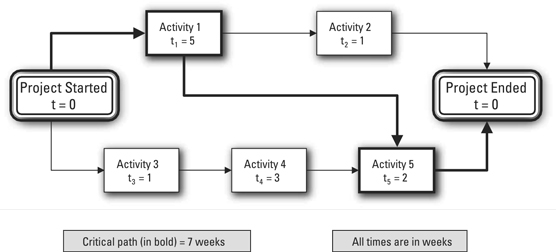Factors that affect predecessors
A predecessor to an activity (Activity A, for example) is an activity or milestone that determines when work on Activity A can begin. PMBOK 6 identifies the following four relationships that can exist between a predecessor and the activity or milestone coming immediately after it (termed its successor):- Finish-to-start: The predecessor must finish before the successor can start.
- Finish-to-finish: The predecessor must finish before the successor can finish.
- Start-to-start: The predecessor must start before the successor can start.
- Start-to-finish: The predecessor must start before the successor can finish.
Sometimes an activity can’t start precisely when its predecessor is finished. A lag is the amount of time after its predecessor is completed that you must wait before an activity can start. A lead is the amount of time before its predecessor is finished that an activity can begin. This book considers only situations where lead and lag times are zero.
An activity is an immediate predecessor to Activity A if you don’t have any other activities between it and Activity A. When you determine the immediate predecessors for every activity, you have all the information you need to draw your project’s network diagram. The following considerations affect the order in which you must perform your project’s activities:
- Mandatory dependencies: These relationships must be observed if project work is to be a success. They include
- Legal requirements: Federal, state, and local laws or regulations require that certain activities be done before others. As an example, consider a pharmaceutical company that has developed a new drug in the laboratory and demonstrated its safety and effectiveness in clinical trials. The manufacturer wants to start producing and selling the drug immediately but can’t. Federal law requires that the company obtain Food and Drug Administration (FDA) approval of the drug before selling it.
- Procedural requirements: Company policies and procedures require that certain activities be done before others. Suppose you’re purchasing new furniture for your company’s offices. You’ve finished selecting and pricing the furniture you want and would like to begin the process of selecting a vendor and placing the order. However, your organization follows a procurement process for large purchases, which requires that the vice president of finance formally approve the expenditure of the funds required before you can proceed.
- Hard logic: Certain processes must logically occur before others. For example, when building a house, you must pour the concrete for the foundation before you erect the frame.
- Discretionary dependencies: You may choose to establish these relationships between activities, but they aren’t required. They include
- Logical dependencies: Performing certain activities before others sometimes seems to make the most sense. Suppose you’re writing a report. Because much of Chapter 3 depends on what you write in Chapter 2, you decide to write Chapter 2 You can write Chapter 3 first or work on both at the same time, but that plan increases the chance that you’ll have to rewrite some of Chapter 3 after you finish Chapter 2.
- Managerial choices: Sometimes you make arbitrary decisions to work on certain activities before others. Consider that you have to perform both Activity C and Activity D. You can’t work on them at the same time, and you know of no legal or logical reason why you should work on one or the other first. You decide to work on Activity C first.
- External dependencies: Starting a project activity may require that certain work external to the project be completed first. For example, imagine that your project includes an activity to test a device you’re developing. You want to start testing right away, but you can’t start this activity until your organization’s test laboratory receives and installs a new piece of test equipment they plan to order.
Choosing immediate predecessors
You can decide on the immediate predecessors for your project’s activities in one of two ways:- Front-to-back: Start with the activities you can perform as soon as your project begins and work your way through to the end. To use this method, follow these steps:
- Select the first activity or activities to perform as soon as your project starts.
- Decide which activity or activities you can perform when you finish the first ones (from Step 1).
- Continue in this way until you’ve considered all activities in the project.
- Back-to-front: Choose the activity or activities that will be done last on the project and continue backward toward the beginning. To use this method, follow these steps:
- Identify the last project activity or activities you’ll conduct.
- Decide which activity or activities you must complete right before you can start to work on the last activities (from Step 1).
- Continue in this manner until you’ve considered all activities in your project.
 An example of a network diagram.
An example of a network diagram.| Activity Code | Activity Description | Immediate Predecessors |
| 1 | Activity 1 | None |
| 2 | Activity 2 | 1 |
| 3 | Activity 3 | None |
| 4 | Activity 4 | 3 |
| 5 | Activity 5 | 1, 4 |
Determine precedence based on the nature and requirements of the activities, not on the resources you think will be available. Suppose Activities A and B of your project can be performed at the same time but you plan to assign them to the same person. In this case, don’t make Activity A the immediate predecessor for B, thinking that the person can work on only one activity at a time. Instead, let your diagram show that A and B can be done at the same time. Later, if you find out you have another person who can help out with this work, you can evaluate the impact of performing Activities A and B at the same time.
When you create your network diagram for simple projects, consider writing the names of your activities and milestones on sticky-back notes and attaching them to chart paper or a wall. For more complex projects, consider using an integrated project-management software package.

